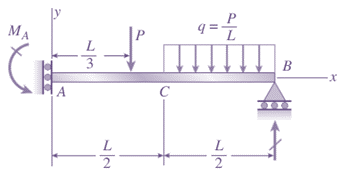
Concept explainers
-23 The beam shown in the figure has a sliding support at A and a roller support at B. The sliding support permits vertical movement but no rotation. Derive the equation of the deflection curve and determine the deflection

Derive the equations of the deflection curve and determine the deflection
Answer to Problem 9.3.23P
Equations of deflection curve:
For
For
For
Deflection at end A,
Deflection at point C,
Explanation of Solution
Given:

For
B.C 1:
Therefore,
For
For
B.C 2:
Therefore,
B.C 3:
Therefore,
B.C 4:
Therefore,
B.C 5:
Therefore,
B.C 6:
From (1) − (5):
For
For
For
So,
And
Want to see more full solutions like this?
Chapter 9 Solutions
Mechanics of Materials, SI Edition
- -18 The beam shown in the figure has a sliding support at A and a spring support at B, The sliding support permits vertical movement but no rotation. Derive the equation of the deflection curve and determine the deflection Bat end B due to the uniform load of intensity q. Use the second-order differential equation of the deflection curve.arrow_forwardThe cantilever beam ACB shown in the figure supports a uniform load of intensity q throughout its length. The beam has moments of inertia I2and IYin parts AC and CB, respectively. Using the method of superposition, determine the deflection SBat the free end due to the uniform load. Determine the ratio r of the deflection 6Bto the deflection 3Xat the free end of a prismatic cantilever with moment of inertia /] carrying the same load. Plot a graph of the deflection ratio r versus the ratio 12 //t of the moments of inertia. (Let 7, tlxvary from I to 5.)arrow_forward-10 Derive the equations of the deflection curve for beam AB with sliding support at A and roller support at B, supporting a distributed load of maximum intensity q0acting on the right-hand half of the beam (see figure). Also, determine deflection A, angle of rotation B , and deflection cat the midpoint. Use the fourth-order differential equation of the deflection curve (the load equation).arrow_forward
- Derive the equation of the deflection curve for beam AB with sliding support at A and roller at B* carrying a triangularly distributed load of maximum intensity q0(see figure). Also, determine the maximum deflection ôniill of the beam. Lsc the fourth-order differential equation of the deflection curve (the load equation).arrow_forwardThe cantilever beam ACB shown in the figure has moments of inertia /, and I{in parts AC and CB, respectively. Using the method of superposition, determine the deflection 8Bat the free end due to the load P. Determine the ratio r of the deflection 8Bto the deflection S:at the free end of a prismatic cantilever with moment of inertia /] carrying the same load. Plot a graph of the deflection ratio r versus the ratio 12 //L of the moments of inertia. (Let /, II- vary from I to 5.)arrow_forwardA horizontal load P acts at end C of the bracket ABC shown in the figure. Determine the deflection 6Cof point C. Determine the maximum upward deflection 8 of member AB. Note: Assume that the flexural rigidity EI is constant throughout the frame. Also, disregard the effects of axial deformations and consider only the effects of bending due to the load P.arrow_forward
- -3 The simple beam AB shown in the figure has moments 2M0and A/0 acting at the ends. Derive the equation of the deflection curve, and then determine the maximum deflection max Use the third-order differential equation of the deflection curve (the shear-force equation).arrow_forward-6 Calculate the maximum deflection of a uniformly loaded simple beam if the span length L = 2.0 m, the intensity of the uniform load q = 2.0 kN/m, and the maximum bending stress = 60 MPa, The cross section of the beam is square, and the material is aluminum having modulus of elasticity E = 70 GPa. (Use the formulas of Example 9-1.)arrow_forward-22 Derive the equations of the deflection curve for a simple beam AB with a distributed load of peak intensity q0acting over the left-hand half of the span (see figure). Also, determine the deflection cat the midpoint of the beam. Use the second-order differential equation of the deflection curve.arrow_forward
- -2 A simple beam AB is subjected to a distrib uted load of intensity q(x) = q0sin x/L, where q0is the maximum intensity of the load (see figure). Derive the equation of the deflection curve, and then determine the deflection max at the midpoint of the beam. Use the fourth-order differential equation of the deflection curve (the load equation).arrow_forward-33 Find the horizontal deflection hand verti cal deflection vat the free end C of the frame ABC shown in the figure. (The flexural rigidity EI is con stant throughout the frame.) Note: Disregard the effects of axial deformations and consider only the effects of bending due to the load P.arrow_forward-6 A cantilever beam .4B is subjected to a parabolically valying load of intensity q(x)=q0(L2x2)/L2 where q0is the maximum intensity of the load (see figure). Derive the equation of the deflection curve, and then determine the deflection Band angle of rotation Bat the free end. Use the fourth-order dif ferential equation of the deflection curve (the load equation).arrow_forward
 Mechanics of Materials (MindTap Course List)Mechanical EngineeringISBN:9781337093347Author:Barry J. Goodno, James M. GerePublisher:Cengage Learning
Mechanics of Materials (MindTap Course List)Mechanical EngineeringISBN:9781337093347Author:Barry J. Goodno, James M. GerePublisher:Cengage Learning
